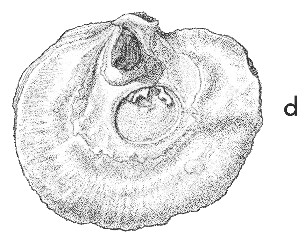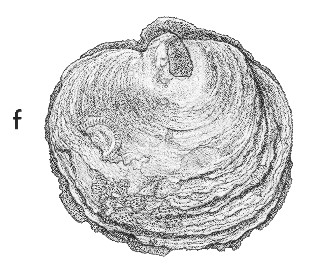
Revised descriptions of New Zealand Cenozoic Mollusca from Beu and Maxwell (1990)

 | Revised descriptions of New Zealand Cenozoic Mollusca from Beu and Maxwell (1990) | 
|
  (Pl. 39d): Nukumaru Brown Sand, Nukumaru Beach, west of Wanganui, Nukumaruan (TM3922, GNS) |
  (Pl. 39f): Nukumaru Brown Sand, Nukumaru Beach, west of Wanganui, Nukumaruan (TM3922, GNS) |
Beu & Maxwell (1990): Chapter 15; p. 308; pl. 39 d,f.
Synonymy: Anomia undata Hutton 1885b, p. 324; Patro (Prismatro) undatus
Type species of Prismatro Marwick, 1948 (= Patro Gray, 1850)
Classification: Anomiidae: Anomiinae
Description: Large for family (60-98 mm long), oyster-like, calcitic, very thick and heavy for family; most specimens regularly oval to circular in outline, with almost flat right (lower) valve and moderately arched left (upper) valve, both with shallow, saddle-shaped flexure in commisure at posterior end. Left valve coarsely lamellar in structure, whereas right (lower) valve very thick and prismatic (breaking into many fibrous crystals at right-angles to valve surface). Exterior smooth, except for very weak radial threads on some small specimens, and lamellar growth ridges. Right valve with deep, circular byssal notch closed off to slit in mid-dorsal margin, tightly enclosing calcified byssal plug; above byssal notch, at dorsal margin, is a large, strongly protruding resilial process with saddle-shaped dorsal surface. Central, roughly circular, thin, white, aragonitic layer surrounds resilifer, byssus, and large, central, circular or oval, adductor muscle scar. In left valve, large resilial scar lies inside weakly protruding umbo; central, irregularly oval, aragonitic layer surrounds 3 muscle scars arranged roughly in a straight line (not a triangle, as in Anomia); upper and middle muscle scars (scars of divided byssal retractor muscle) both oval, upper one moderate-sized, middle one small; valve adductor (lowest) scar almost circular and much the largest.
Comparison: Patro undatus is the largest of New Zealand Anomiidae, easily recognised by the thick, prismatic right valve retaining the byssal plug by constriction. Yonge (1977) greatly clarified knowledge of the Anomiidae, confirming the generic status of Patro. Anomia has a loose byssal plug, the right valve of lamellar (rather than prismatic) structure, the muscle scars in the left valve in a triangle (the uppermost (one of the two byssal retractors) much the largest), and is much more irregular in shape. Middle Cenozoic species of Pododesmus have the relatively small byssal plug fused into the shell, a lamellar rather than prismatic right valve, and only two muscle scars in the left valve (the byssal retractor is not subdivided). Anomia lives today attached to rocks and shells in crevices and on rough surfaces, and has an irregular shape, but Patro undatus appears to have been attached only while small, and to have been free-lying on the sea-bed when more than about 30 mm in diameter. The Recent type species, Patro australis (Gray, 1850), lives today in shallow water around northern Australia.
Distribution: Kapitean-Opoitian ?; Waipipian-Nukumaruan. Limestone, "Petane", i.e., hillside north of mouth of Esk River, 20 km north of Napier, Hawke's Bay (type); common in Pliocene shellbeds and shelf sandstone to mudstone facies, oyster banks, and coquina limestone throughout New Zealand, and particularly in the Waipipi Shellbeds, Waverley Beach, west of Wanganui (Waipipian), and Mangapani and Wilkies Shellbeds, Wanganui basin (Mangapanian), Nukumaru Limestone (where the most complete right valves are found, at Fishing Rock) and Nukumaru Brown Sand at Nukumaru Beach, Wanganui, and the Petane Group mudstone and limestone cycles throughout Hawke's Bay (Nukumaruan). The time range is unclear; Kapitean-Opoitian anomiids (particularly from the coast between Te Araroa and East Cape, Kapitean) include some specimens that seem to be P. undatus.
Cite this publication as: "A.G. Beu and J.I. Raine (2009). Revised
descriptions of New Zealand Cenozoic Mollusca from Beu and Maxwell (1990). GNS
Science miscellaneous series no. 27."
© GNS Science, 2009
ISBN
978-0-478-19705-1
ISSN 1177-2441
(Included with a PDF facsimile file
copy of New Zealand Geological Survey Paleontological Bulletin 58 in CD version
from: Publications Officer, GNS Science, P.O. Box 30368 Lower Hutt, New
Zealand)